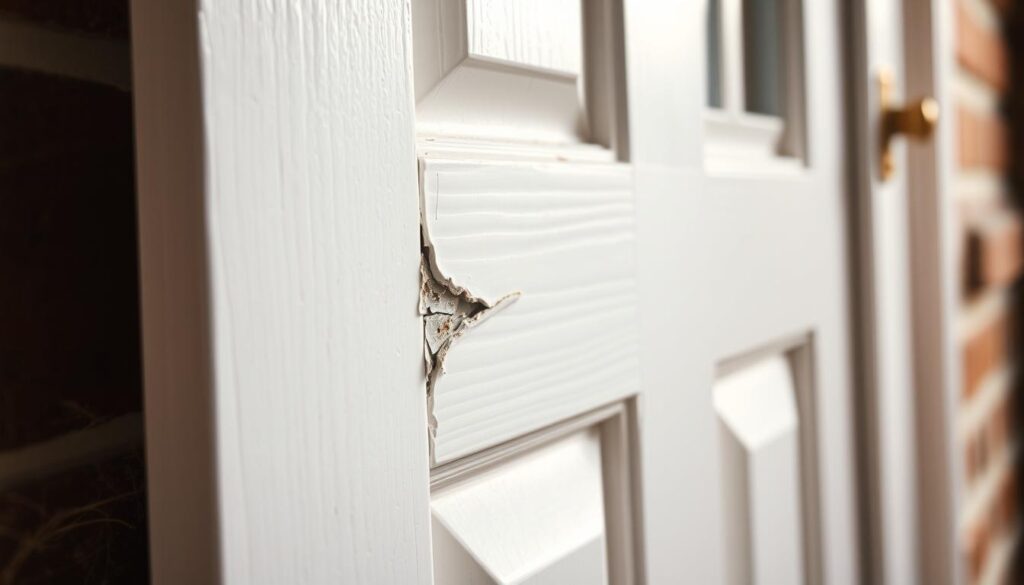Have you ever faced the frustration of a dented uPVC door panel, wondering if it’s time for a costly replacement? A damaged entryway can affect both the appearance and functionality of your home.
Fortunately, with the right tools and techniques, most dented uPVC door issues can be resolved without needing a full replacement, saving you money and extending the lifespan of your door.
Our comprehensive guide will walk you through the process of assessing the damage and completing the necessary repairs, ensuring your door is restored to its original condition.
Key Takeaways
- Assess the extent of the damage to determine the best course of action for repair.
- Use the right tools and materials to ensure a successful uPVC door repair.
- Follow a step-by-step guide to restore your door’s original appearance and functionality.
- Learn when it’s necessary to seek professional help for more complex damages.
- Extend the lifespan of your uPVC door with proper maintenance and timely repairs.
Understanding uPVC Door Panel Damage
Understanding the causes and extent of uPVC door panel damage is crucial for effective repairs. When it comes to front doors, cracked uPVC can be a major security risk and should be fixed as soon as possible.
Common Causes of Dents in uPVC Door Panels
Dents in uPVC door panels can occur due to accidental impacts or external forces. Common causes include mishandling, collisions with objects, or even extreme weather conditions. To prevent such damage, it’s essential to be mindful of your door’s surroundings.
Assessing the Severity of the Damage
Before beginning any repair work, carefully examine the dented area to determine the depth, width, and overall severity of the damage to your uPVC door. Consider the following factors:
- Minor dents (less than 5mm deep) without cracking can typically be repaired.
- Deeper dents or those with associated cracks may require panel replacement.
- Check if the damage extends to the door’s functional components.
Assessing these factors will help you decide the best course of action for youruPVC doorrepairor potential replacement.
Tools and Materials Needed to Repair Dented uPVC Door Panel
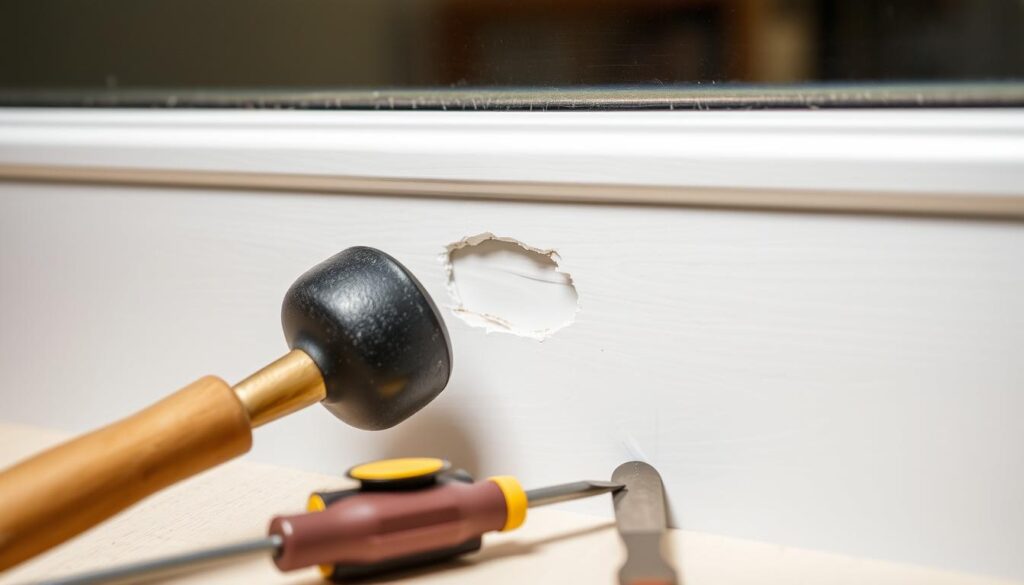
Before starting the repair, it’s essential to have the correct tools and materials for the job. Repairing a dented uPVC door requires a specific set of tools and materials to achieve a successful outcome.
Essential Tools for the Job
The essential tools for repairing a dented uPVC door panel include a variety of basic hand tools and cleaning materials. You’ll need cleaning materials such as isopropyl alcohol or acetone to thoroughly clean the damaged area before applying any fillers or adhesives.
Recommended Materials and Fillers
The most effective materials for repairing dented uPVC door panels include two-part epoxy fillers specifically designed for plastic repairs, which provide excellent adhesion and durability. Other recommended materials include auto body filler (Bondo), a high-quality plastic primer, and uPVC-compatible paint in a matching colour. Additionally, a clear acrylic sealant can be useful for sealing the edges of repairs and providing additional waterproofing to the repaired area.
Safety Precautions Before Starting Repairs
Safety should be your top priority when fixing a dented uPVC door to ensure a smooth and accident-free repair process. Ensuring your safety while repairing your door is crucial, and there are several precautions you can take.
Protective Equipment to Use
When working on your uPVC door, it’s essential to wear protective gear. This includes gloves to protect your hands from sharp edges and safety glasses to prevent eye damage from debris. “Safety is not just a precaution, it’s a necessity,” as the saying goes, emphasizing the importance of being prepared.
Working Safely with uPVC Materials
To work safely with uPVC materials, always ensure good ventilation, especially when using fillers or cleaners that release fumes. Be cautious when handling these materials, and follow the manufacturer’s instructions. Some key safety measures include working in a well-ventilated area, maintaining temperature control when using a heat gun, securing the door properly, and keeping tools out of reach of children and pets.
- Always work in a well-ventilated area to avoid inhaling harmful fumes from chemicals.
- Be aware of the risks associated with heating uPVC, such as producing toxic fumes.
- Secure your door properly to prevent it from swinging or falling.
By following these guidelines, you can minimize risks during the repair process and ensure a successful outcome for your uPVC door.
Preparing Your uPVC Door for Repair
Preparing your uPVC door for repair is a crucial step that ensures a successful outcome. To start, you need to assess the damage and clean the area around it.
Cleaning the Damaged Area
Begin by cleaning the damaged area thoroughly to remove any dirt or debris that may interfere with the repair. Use a mild detergent and water to clean the area, and dry it completely before proceeding.
- Use a soft cloth to avoid scratching the uPVC surface.
- Ensure the area is dry to prevent any further damage.
Removing the Door Panel (If Necessary)
If the damage is extensive, it may be necessary to remove the door panel from the door frame for easier access. To do this, identify how the panel is attached—typically with screws or plastic trim pieces. Use a flat screwdriver to carefully pry away the trim pieces, and label any screws or fixings as you remove them.
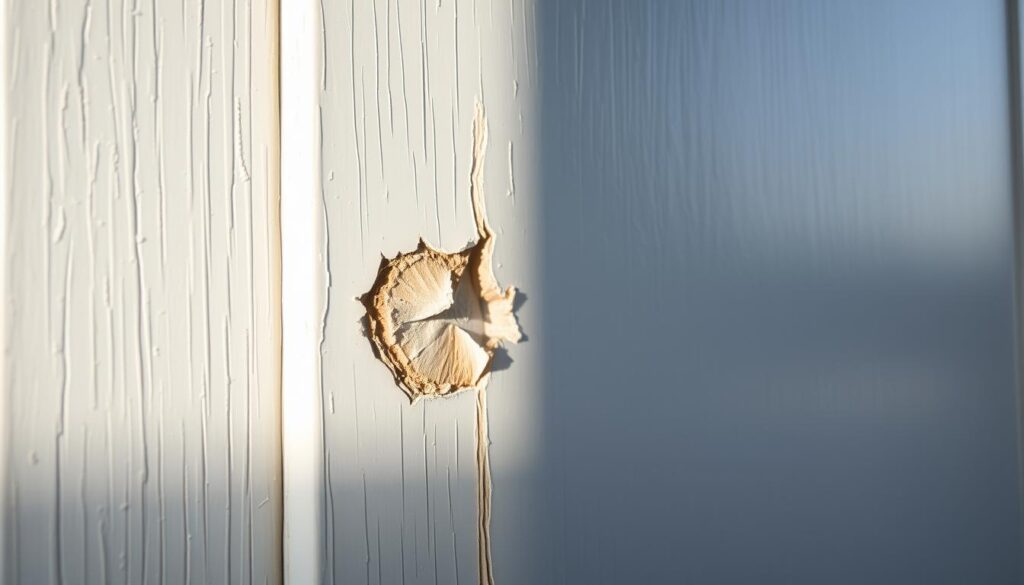
- Take photographs or make detailed notes about how the panel is installed before removal.
- Place a blanket or soft material on the floor to protect the panel when you remove it.
Step-by-Step Guide to Repair Dented uPVC Door Panel
Repairing a dented uPVC door panel can be a straightforward DIY task if you follow the right steps. This guide will walk you through the process, ensuring your uPVC door looks as good as new.
Step1: Removing the Panel from the Frame
To begin, you need to remove the uPVC door panel from its frame. This will give you clear access to the dented area. Carefully take out the screws or clips holding the panel in place, and gently pull it away from the frame.
Step2: Filling the Dented Area
Once the panel is removed, fill any dents or dimples using a suitable filler material like wood putty or bondo. Apply a clear acrylic sealant if there are cracks to prevent further damage.
Step3: Sanding and Finishing
After the filler has cured, sand the area with progressively finer sandpaper (120-grit, 240-grit, and finally 400-grit) to achieve a smooth finish. Clean the area thoroughly before applying a uPVC-compatible primer and paint. Finish with a clear protective sealant for added durability.
Reattaching and Realigning the Door Panel
With the repairs done, carefully reattaching and realigning the uPVC door panel is necessary. This step is crucial to ensure the door functions properly and maintains its weatherproofing properties.
Proper Alignment Techniques
To align the panel correctly, start by positioning it within the door frame. Ensure it fits snugly and evenly. You may need to adjust the panel slightly to achieve the perfect alignment. Check that the panel is not obstructing any locking mechanisms or other door components. For more detailed guidance on uPVC door repairs, you can visit valuedoors.co.uk.
Securing the Panel Back in Place
Once you’re satisfied with the alignment, begin securing the panel back into the door frame using the original fixings or new ones if necessary. Replace screws one at a time, starting from the centre and working outward. Avoid over-tightening screws in uPVC frames, as this can cause damage. If your panel includes decorative beading or trim, use a rubber mallet to tap it back into place gently.
| Task | Description |
|---|---|
| Aligning the Panel | Position the panel within the door frame, ensuring a snug and even fit. |
| Securing the Panel | Use original or new fixings, replacing screws from the centre outward. |
| Checking the Panel | Gently press on various points to ensure there’s no movement or flexing. |
Dealing with Additional uPVC Door Issues
When it comes to uPVC doors, issues like misalignment and cracks are common problems that need to be addressed. Apart from dents, your uPVC door can suffer from other issues that affect its functionality and overall appearance.
Fixing Cracks in uPVC Doors
Cracks in uPVC doors can be unsightly and compromise the door’s integrity. To fix cracks, you can use a suitable filler, such as a two-part epoxy-based filler, and then sand it down to a smooth finish. Ensure the area is clean and dry before applying the filler for a durable repair.
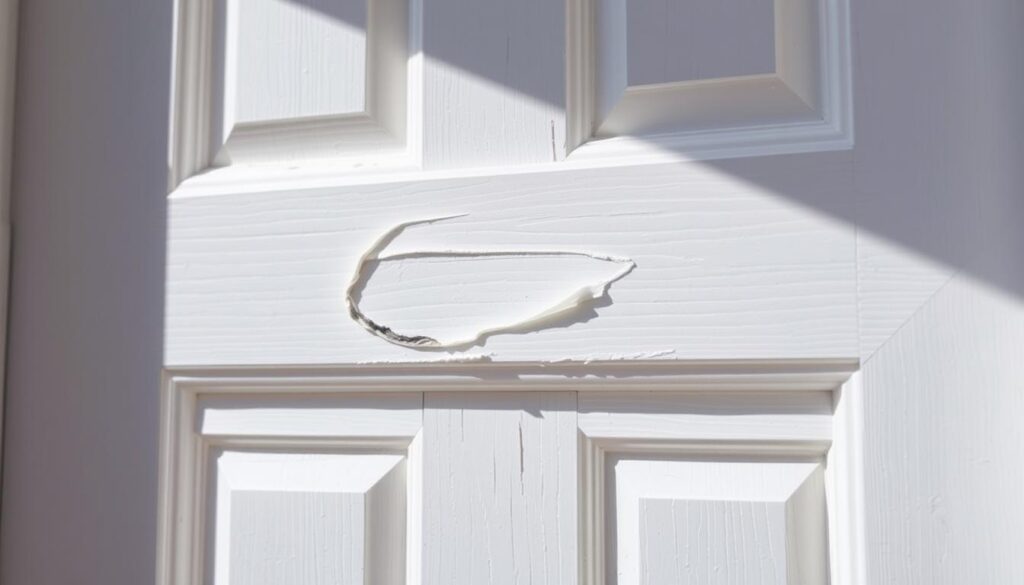
Addressing Misaligned uPVC Doors
Misaligned uPVC doors can cause problems with closing, locking, and weatherproofing. To address this, start by checking the hinges and adjusting the screws that control the door’s position. You can use an Allen key to make the necessary adjustments. Make small, incremental changes and test the door’s operation after each adjustment to avoid over-correction. If the issue persists, check whether the frame itself has warped, which may require professional intervention.
- Check the hinges and adjust the screws to realign the door.
- Use an Allen key to make the necessary adjustments.
- Apply a silicone-based lubricant to the hinges after realigning the door.
When to Call a Professional for uPVC Door Repairs
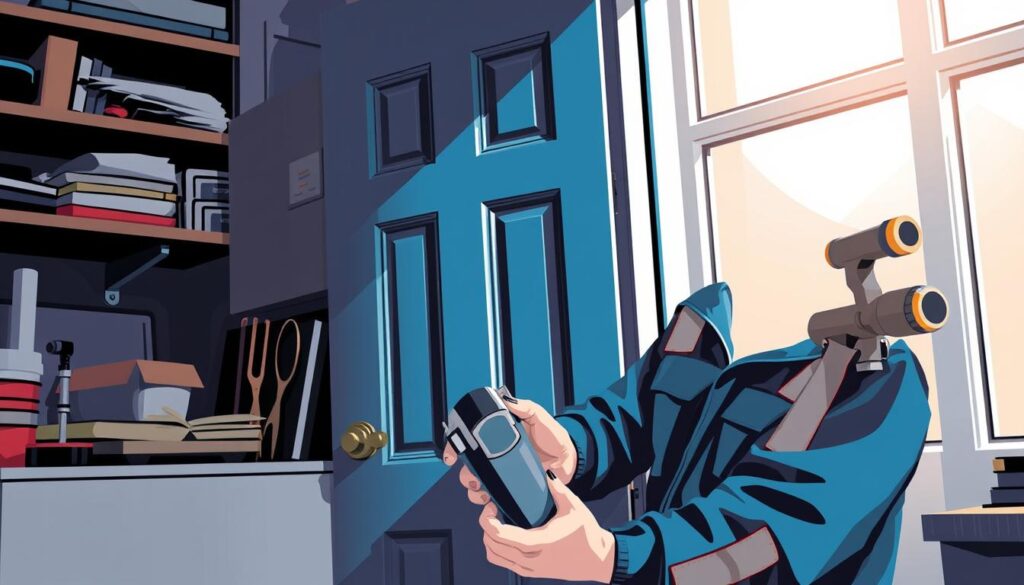
While DIY repairs can be cost-effective, there are instances where seeking professional help is necessary for uPVC door repairs. This is particularly true when the damage is extensive or you’re unsure about the repair process.
Signs the Damage Is Beyond DIY Repair
If your uPVC door has significant dents, cracks, or is misaligned, it may be beyond simple DIY fixes. Additionally, if the door’s locking mechanism or hinges are damaged, professional assistance is recommended to ensure security and proper functionality.
Finding a Qualified uPVC Door Specialist
To find a qualified uPVC door specialist, look for professionals who are members of recognised trade associations. You can also ask for recommendations from friends or family, check online reviews, and verify the specialist’s qualifications and insurance. Ensure they offer a warranty on their repair work for your peace of mind.
Cost Considerations for uPVC Door Repairs
When considering repairs for your uPVC door, cost is a crucial factor to evaluate. The expense of fixing a dented uPVC door panel can vary widely depending on whether you opt for a DIY repair or hire a professional.
DIY Repair Costs vs. Professional Services
DIY repairs can be cost-effective, requiring only basic tools and materials. However, if you’re not confident in your ability to fix the damage, hiring a professional might be the better choice, despite the higher upfront cost.
| Repair Type | Cost Range (£) |
|---|---|
| DIY Repair | 20-100 |
| Professional Repair | 100-500 |
When Replacement Might Be More Cost-Effective
There are situations where replacing your uPVC door might be more economical than repairing it, such as when the door is old or the damage is extensive. Consider the age of your door, the extent of the damage, and potential energy savings when deciding.
Maintaining Your uPVC Door to Prevent Future Damage
Maintaining your uPVC door is essential to prevent future damage and ensure longevity. Regular maintenance can help minimise the effects of wear and tear, keeping your door in prime condition.
Regular Cleaning and Inspection Tips
To maintain your uPVC door, start by cleaning the door frames, panes, and hardware using a mild soap solution. Avoid harsh chemicals, as they can damage the uPVC material. Regular inspection of the hinges, locks, and handles is also crucial. Apply silicone-based lubricants to these moving parts to prevent stiffness and prolong their lifespan.
Seasonal Maintenance Recommendations
Seasonal maintenance is vital to address the changing environmental conditions. Here are some key tasks to perform:
- In spring, clean your uPVC door and frame to remove winter grime and salt residue.
- Apply silicone-based lubricant to hinges, locks, and handles before summer.
- During summer, consider shading your uPVC door from direct sunlight to prevent warping.
- Before autumn, check and clean drainage channels and weather seals.
- In winter, avoid using de-icing salts near your uPVC door and consider applying a protective wax.
| Season | Maintenance Task |
|---|---|
| Spring | Clean door and frame, remove winter grime |
| Summer | Shade door from direct sunlight |
| Autumn | Check and clean drainage channels and weather seals |
| Winter | Avoid de-icing salts, apply protective wax |
Conclusion
With the right preparation and techniques, you can effectively repair your uPVC door panel and maintain your home’s security and energy efficiency. Repairing a dented uPVC door is a manageable DIY project that can save you significant costs. The key to successful uPVC door repairs lies in thorough preparation, including cleaning and assessing the damage.
For minor to moderate dents, the filling and refinishing method can restore both the appearance and functionality of your door panel. Regular maintenance, including cleaning and lubricating moving parts like locks, can prevent more serious issues. If you’re unsure about tackling the repair yourself, don’t hesitate to seek professional assistance to ensure the job is done correctly.
By addressing door repairs promptly, you can maintain your home’s aesthetic appeal and functionality. Whether you choose to DIY or hire a professional, taking care of your uPVC door will extend its lifespan and keep it looking its best.
